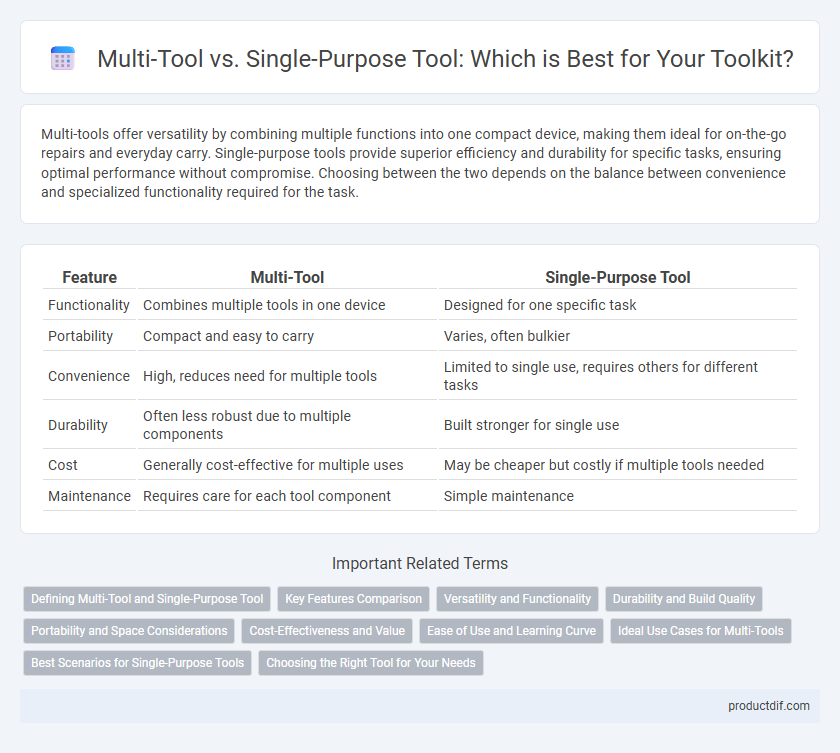Multi-tools offer versatility by combining multiple functions into one compact device, making them ideal for on-the-go repairs and everyday carry. Single-purpose tools provide superior efficiency and durability for specific tasks, ensuring optimal performance without compromise. Choosing between the two depends on the balance between convenience and specialized functionality required for the task.
Table of Comparison
| Feature | Multi-Tool | Single-Purpose Tool |
|---|---|---|
| Functionality | Combines multiple tools in one device | Designed for one specific task |
| Portability | Compact and easy to carry | Varies, often bulkier |
| Convenience | High, reduces need for multiple tools | Limited to single use, requires others for different tasks |
| Durability | Often less robust due to multiple components | Built stronger for single use |
| Cost | Generally cost-effective for multiple uses | May be cheaper but costly if multiple tools needed |
| Maintenance | Requires care for each tool component | Simple maintenance |
Defining Multi-Tool and Single-Purpose Tool
A multi-tool is a compact, versatile device integrating several individual tools like pliers, screwdrivers, and knives into one unit, designed for convenience and adaptability. A single-purpose tool is engineered for a specific function, such as a hammer or a tape measure, providing superior performance and durability in that particular task. Understanding the distinction helps users choose between portability and specialized efficiency based on their needs.
Key Features Comparison
Multi-tools combine several functions such as pliers, screwdrivers, and knives in a compact design, offering versatile utility for varied tasks. Single-purpose tools excel in durability and precision, tailored specifically for one function, providing superior performance in specialized applications. Comparing key features, multi-tools prioritize portability and multifunctionality, while single-purpose tools emphasize specialized quality and ergonomic design for specific tasks.
Versatility and Functionality
Multi-tools offer exceptional versatility by combining several functions into one compact device, making them ideal for tasks requiring quick transitions between different tools. Single-purpose tools, while limited to one function, provide superior performance and durability for specialized jobs, often delivering more precise results. Choosing between a multi-tool and a single-purpose tool depends on the balance between convenience and the need for specialized functionality in specific applications.
Durability and Build Quality
Multi-tools are designed with compactness and versatility, often incorporating stainless steel or high-grade alloy components that balance durability with lightweight convenience, though they may sacrifice some strength compared to single-purpose tools. Single-purpose tools typically feature robust construction with specialized materials and reinforced parts, delivering superior durability and longer lifespan under heavy or repetitive use. Choosing between the two depends on the need for portability versus maximum durability and build quality tailored to specific tasks.
Portability and Space Considerations
Multi-tools offer enhanced portability by combining multiple functions in a compact design, reducing the need to carry several single-purpose tools. Single-purpose tools, while often more efficient for specific tasks, require more storage space and can be cumbersome to transport in bulk. Choosing a multi-tool optimizes space and convenience, especially for users with limited storage or those needing versatility on the go.
Cost-Effectiveness and Value
Multi-tools consolidate multiple functions into one compact device, significantly reducing the need to purchase and carry individual single-purpose tools, resulting in cost savings and enhanced portability. Single-purpose tools often provide superior durability and performance for specialized tasks, which can translate into longer tool life and reduced maintenance expenses. Evaluating cost-effectiveness depends on the frequency and variety of tasks, with multi-tools offering better value for casual or diverse use, while single-purpose tools excel in professional, specialized applications.
Ease of Use and Learning Curve
Multi-tools offer the advantage of convenience by combining several functions into one device, but they often have a steeper learning curve due to their complex mechanisms and multiple components. Single-purpose tools are generally easier to use and require less time to master, as they are designed for specific tasks with straightforward operation. Ease of use and learning curve considerations often make single-purpose tools preferable for beginners or users focused on efficiency.
Ideal Use Cases for Multi-Tools
Multi-tools excel in scenarios requiring versatility and compactness, making them ideal for outdoor activities, emergency kits, and everyday carry situations where space and weight are critical. Their combination of various functions, such as pliers, screwdrivers, and knives, allows for quick adaptability to diverse tasks without needing multiple separate tools. This versatility enhances efficiency and convenience for users who face unpredictable environments or need reliable solutions on the go.
Best Scenarios for Single-Purpose Tools
Single-purpose tools excel in scenarios requiring high precision and efficiency, such as specialized woodworking or medical procedures where tailored functionality ensures optimal performance. These tools offer greater durability and ease of use for specific tasks compared to multi-tools, reducing setup time and minimizing user fatigue. In industries like automotive repair and electronics, single-purpose tools provide consistent results by addressing exact requirements without compromises.
Choosing the Right Tool for Your Needs
Selecting between a multi-tool and a single-purpose tool depends on the specific tasks and frequency of use. Multi-tools offer versatility with integrated functions like pliers, screwdrivers, and knives, making them ideal for general maintenance or outdoor activities. Single-purpose tools, such as a dedicated hammer or drill, provide superior performance and durability for specialized tasks requiring precision or heavy-duty use.
Multi-Tool vs Single-Purpose Tool Infographic

 productdif.com
productdif.com